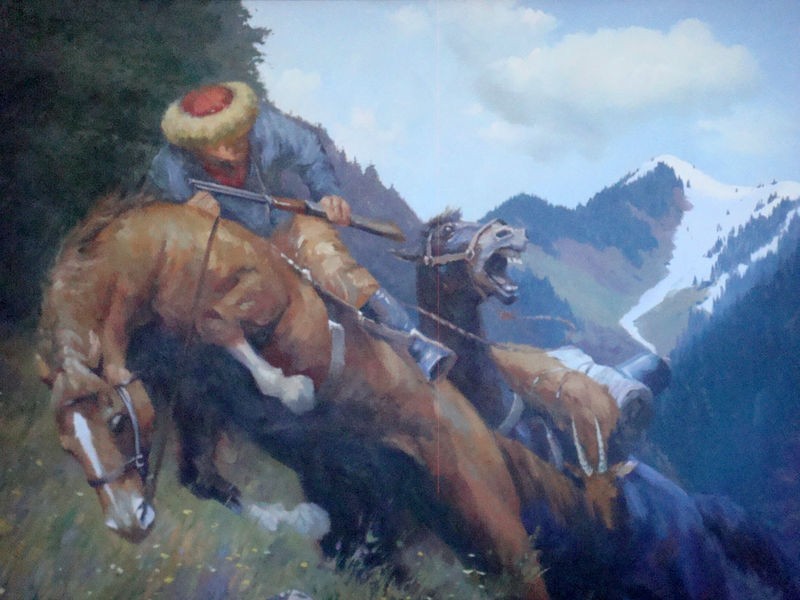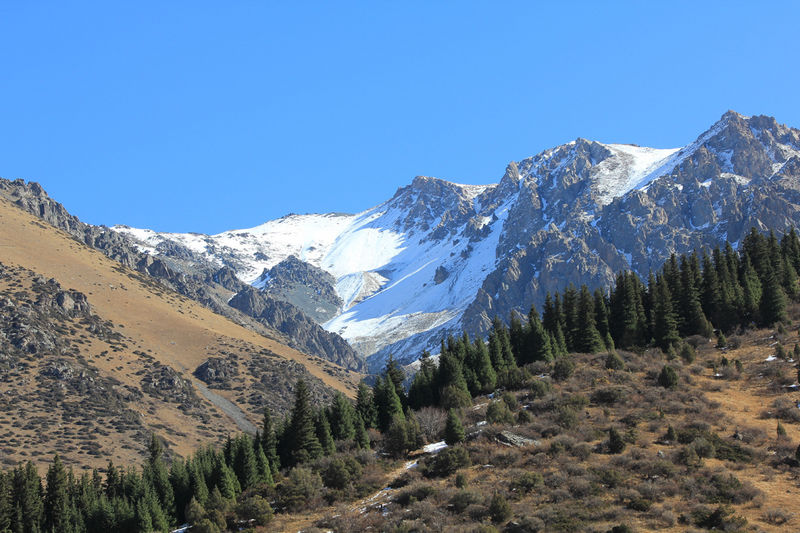The half-moons of the horses’ eyes flash white against the grey of the mountains. A hanging glacier nestles between two peaks. The horses’ effort is visible, their terror palpable. Underfoot a green meadow dotted with yellow daisies seems too idyllic a terrain for this abduction to take place, but abduction it is. The lonely rider, reins of his mount in one hand, rifle in the other – spurs his horse on to pull on the other horse tethered to his saddle. The riderless horse has a sling with a live goat hanging from its side. This is one of the things I encounter on my Kyrgyzstan travel adventure in Central Asia.

Kyrgyzstan travel adventure
This is Kyrgyzstan where the sweet smell of wormwood pervades the blue air of the Tian Shan (Heavenly Mountains) and unfathomably deep lakes shine like mirrors dropped from the sky.
“We really have to go now” –the voice of my guide abruptly shatters my reverie and pulls me away from the art exhibition in the main square of Bishkek, the capital.
The painting I was immersed in depicts exactly the landscape I had just traversed as part of a World Expeditions’ Silk Road trip: the mountainous Kyrgyz paradise bordering with China and also, as I was to discover, where an underlying streak of violence manifested in raids, cattle rustling, bride kidnapping and the national sport of Kok Boru or dead goat polo co-exist.

Kok Boru echoes ancient struggles connected to cattle rustling and bride kidnapping all requiring high mobility involving horses, the trademark of nomadic tribes.
Kyrgyz, Kazakhs, Afghans, Uzbekis, Hazzaras, Tajiks and Pashtuns practice the sport, which consists of two mounted teams of variable numbers struggling to hurl the dead carcass over a goal post (at some point I am told it used to be a live animal).
A calf carcass sometimes replaces a goat so you can imagine how heavy this is. I’ve once seen a game in rural Kyrgyzstan played with the carcass of a wolf.
Genghis Khan
I see more of Genghis Khan in Central Asia than I did in China. The Mongol DNA is imprinted everywhere here: in the faces, the animals and specially in some of the social customs.
Bride kidnapping in Kyrgyzstan today – far from being a dead custom, as my very urban guide claims – is still practiced in rural areas albeit in a stylised manner: generally agreed upon by bride and groom and carried out from the back of a small truck.
My guide is not a blood Kyrgyz and seems embarrassed to be associated with the practice.
The population of Kyrgyzstan – like the populations of all the other ‘Stans’ – has a sizable Russian presence, the result of years of domination in Central Asia. But I know at least two people who have witnessed bride kidnapping first hand.
One of them is Tim Cope, author of On the Trail of Genghis Khan, who in neighbouring Kazakhstan, was invited to take part in one such event.
He points out that “across the steppe’s nomad societies it had always been essential to marry someone who was not related to the paternal line for at least seven generations back.”

Many more peaceful pursuits survive in Kyrgyzstan: such as the felt-making workshops run by women’s cooperatives. Gers (or yurts) are not much in demand these days but the skills are applied to the making of beautiful toys and souvenirs.

Adventure in Central Asia
If you are crossing as we did from China to Kyrgyzstan over the Torugart Pass, I highly recommend a detour to the 15th century stone caravanserai of Tash Rabat, an astonishing building which is thought to have been a Nestorian monastery built in the tenth century and later on used as a caravanserai where itinerant merchants, monks, magicians, musicians and dancing girls stopped to rest and resupply.
Tash Rabat is located east of the main north-south highway on your way to the capital.

But this is not all, this amazing crossroads country in Central Asia has remains that are thousands of years old such as fields of Balbals, the monolithic prehistoric statues that were usually placed around a grave mound in antiquity.
These extremely attractive ‘grandfather stones’ are said to be of Turkic origin occurring in many countries including Korea.
They are simple stellae or menhirs depicting ancestors easily identifiable by a headdress or other details. They never have legs and they are always half-interred in a line leading to a main tomb or around one.

Burana, only 80Km from Bishkek, has an impressive tower built around the 10th-century, surrounded by a field of Balbals.
Some of these stone statues were found originally there but most come from other regions of Kyrgyzstan, making it difficult to identify them -but at least they have survived.
The Burana Tower itself, originally 45m tall and now slightly shorter and listing to one side due to seismic shifting, has a strange story attached to it. Legend has it that a witch warned a King that his newborn daughter would die at the age of 18.
To avoid this calamity the King built a tower and kept his daughter in it, never allowing her to leave. One day a poisonous spider bit her and she died. She was eighteen at the time.

Kyrgyzstan will surprise you with starkly different landscapes. From the high altitude desert where mountains look as if made out of gingerbread dusted with icing sugar, to alpine meadows framed by snowy peaks and crisscrossed by crystalline streams.

You will travel along horse breeders taking their herds to market and hundreds of fat-tail sheep will flank your vehicle herded by farmers on horseback wearing sheepskin-lined coats.
Stop for a taste of fermented mare’s milk on the way from a roadside stall if you are brave (it was Genghis Khan’s preferred tipple).
Maria Visconti travelled as a guest of World Expeditions. Kyrgyzstan is part of World Expeditions trip The Silk Road from Xi’an to Samarkand via Kashgar.
Discover Kyrgyzstan
Kyrgyzstan is a budget friendly travel destination that is easier to get around than you might think. You can get around by air and by road. Kyrgzstan has shared taxis and buses. Here’s a Kyrgyzstan travel guide for more practical tips.
If you prefer to go on an organised tour, World Expeditions has a 15-day trip through Kyrgyzstan and the Tian Shan Mountains.

Plan Your Trip

Rent A Car – Find the best car rental rates at Discover Cars. They compare car hire companies to provide you with the best deal right now.

Find A Hotel – If you’re curious about this article and are looking for somewhere to stay, take a look at these amazing hotels.

